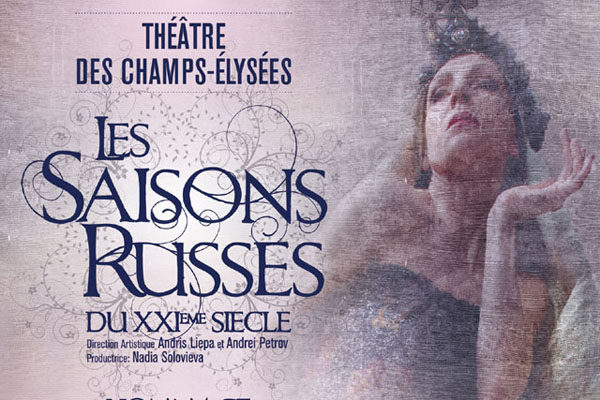
In July, Andris Liepa, former Bolshoi Ballet star turned ballet entrepreneur returns to London with his company Les Saisons Russes du XXIe Siècle from July 16 to 20. Headlining the season is Patrick de Bana’s “Cléopâtre – Ida Rubinstein,” being seen in London for the first time, which is being danced alongside a selection from Mikhail Fokine’s greatest works: “Le Spectre de la Rose”, “Scheherazade”, “Chopiniana”, “Polovetsian Dances” and “The Firebird.”
“Cléopâtre” is not a reconstruction of Diaghilev’s original, but rather a tribute to the enigmatic actress/dancer Ida Rubinstein and star of the Ballets Russes who danced in the title role during the company’s Paris season of 1909. It recounts the story of the creation of the ballet, drawing on history and urban myth to create Rubinstein’s mysterious, glamorous world.
Looking ahead to the season, Liepa kindly agreed to answer a few questions from Ballet-Dance’s Charlotte Kasner about the Liepa Foundation, Diaghilev and recreating the repertoire.
CK: What inspired you to set up the Liepa Foundation?
AL: My father, Maris Liepa, died in 1989 at the age of only 52, before he could open his own company to realise the many plans and ideas he’d been developing. In 1996, [what would have been] the year of my father’s 60th birthday, when I finished dancing, I set up the Maris Liepa Charitable Foundation in order to promote the development of ballet and to continue his work and the many, many creative projects that were always in his mind. Maris’ dream was to do something dedicated to the reconstruction of Fokine’s work. It was the Soviet era (i.e. before ‘glasnost’) and it was a very difficult time to do such things and Fokine was almost forgotten by the Russian people. He was considered a defector when he moved to New York, where he died in 1942. My sister Ilze and I wanted to continue our father’s work so it became a main aim of the foundation to revive lost or forgotten ballet masterpieces such as those by Fokine and to offer scholarships to promising young dancers.
CK: What were your reasons for choosing to present the Diaghilev repertoire?
AL: For many years my father researched and collected materials on Les Saisons Russes in Paris with a view to reviving masterpieces of Russian ballet which Diaghilev presented at the beginning of the century and which had a huge influence on the development of culture all over the world. After the Russian Revolution of 1917, the new Soviet regime tried to lure Diaghilev back to Russia from Europe, but he decided to stay away. As a result he was written out of the history books for more than 60 years. My father was the first to return to Russia a Fokine ballet which had never been performed there: this was “Le Spectre de la Rose” which he revived in 1966 and subsequently taught me how to dance. It was the role Nijinsky became so famous for, and it was my first experience of the Diaghilev repertoire.
Le Spectre de la Rose performed by Maris Liepa
CK: Given that Diaghilev was an exile for a large part of his life, how is he regarded in Russia today?
AL: I’ve been working on this project for more than 20 years and I think we’ve really been able to inspire people to think it’s a great idea to reconstruct the Diaghilev repertoire and to use the name of Saisons Russes. Diaghilev was always ahead of the times. He used machinery and new technology. He used modern equipment for his own productions. He was the first person to use electricity in the theatre in Paris [although it was already in use in London, where the Savoy Theatre was lit this way in 1881]. He practically invented international touring [although Noverre toured extensively across Europe and a few early 19th-century companies toured in Europe and the USA. “Giselle,” for example, had been seen in London, Milan, and Boston and New York within a year of its creation].
Modern audiences want to see something great so I really try to put modern energy into old choreography. If you don’t put the energy in, it’ll look weak and old fashioned. A few years ago a fashionable new club called Diaghilev opened in Moscow and for a few years it was the most popular nightspot in the city. Although the cultural population already knew who he was, he was suddenly a new and fashionable name with a whole new audience.
CK: Do you think that this differs from the way that he is regarded outside of Russia?
AL: Yes, because he was forced out of people’s memories after the Revolution and his repertoire was largely forgotten because it wasn’t performed in Russia. In Europe it was a totally different situation. He was a formidable force in the worlds of opera and ballet, a powerful impresario who collaborated with composers like Stravinsky, who made stars out of Nijinsky, Leon Bakst, Anna Pavlova, and many others including of course George Balanchine who eventually founded New York City Ballet.
CK: Was the Diaghilev repertoire known and/or performed in the Soviet Union?
AL: Just a few ballets such as “Chopiniana,” a couple of versions of “Petrushka” including original choreography by Fokine and a score by Stravinsky, and “The Firebird,” but not really good ones. When I was with the Bolshoi, we performed them only at special occasions. They were never in repertoire.
CK: How have you set about re-creating the repertoire?
AL: I’ve restored everything that exists. For example, I found a great film of “Firebird” with Margot Fonteyn; and in New York, a great version danced by Cynthia Gregory from the 1960s. The premiere of Diaghilev’s “Firebird” was in the Paris Opera and it was done with costumes by Alexander Benois but they were too heavy to carry. Diaghilev destroyed a lot of costumes and sets anyway. I went to Russian libraries and found beautiful sketches by Alexander in St. Petersburg and lots of other material. We premiered the restoration of the original version in 1993 in St Petersburg at the Mariinsky Theatre. It was Fokine’s dream to bring “Firebird” back onto the stage of the Mariinsky; it was never performed while he was alive.
CK: How close do you feel that this version comes to the original presentations?
AL: All versions that I’ve done are close to the materials that exist. I have great admiration for Fokine and Diaghilev, the great designers etc. It’s in my family’s blood and I’ve tried to restore them with admiration and respect.
CK: What have your dancers learned from rehearsing this repertoire?
AL: I think they learn how to make a ballet grow instead of being ‘just’ performers. In the real productions the most important things are acting technique, being a great partner… In modern versions these are sometimes missing.
CK: Does their approach and/or technique need to change from presenting contemporary works?
AL: Probably all the Diaghilev works were revolutionary and totally modern at the time; it was the beginning of modern ballet. Fokine presented the first modern dance in “Firebird” with unusual steps. I think it’s a great situation today. I was working with the Mariinsky three months ago because I have done a production of “Firebird” with them and everybody really loves it. You have to present all these works correctly to the youngsters; it becomes a great experience for them.
CK: Why do you think that the Diaghilev repertoire continues to fascinate audiences more than one hundred years after its creation?
AL: Because he was ahead of his time. People then weren’t ready to take in some of his ideas. Audiences didn’t understand. They hated the music, the costumes, the choreography…but now here we are celebrating his work.
What I have done is to go a little further and start to create new versions. Some of the ballets were totally lost. For example, with “Cleopatra” we started to do the original version, but realised it had weak music that Diaghilev didn’t like so we’ve used different composers. In our version we used the idea of Ida Rubinstein performing in the Paris premiere in 1909. We wanted to show how Ida became a star; not a ballerina, but a great actress. We made this great ballet and dedicated it to Diaghilev.
Charlotte Kasner

